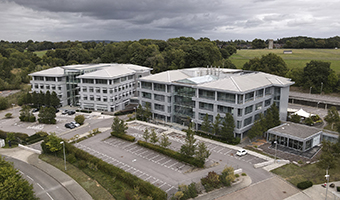At 4.6m sq ft, overall take-up in the South East rebounded from two successive years of under par activity with Reading, Slough and Basingstoke the top performers. Grade A take-up hit a 17 year high of 3.0m sq ft in 2018, with strong inward investment continuing to drive exceptional levels of performance across the South East.
TMT remains the backbone of occupier demand in the South East, with the rapid growth of flexible office providers reflecting a clear structural shift in occupier demand and a race for market share. Activity from serviced offices operators passed 500,000 sq ft in 2018, a threefold increase on 2017 and made up a record 12% share of total take-up.
For a seventh successive year, overall supply contracted across the South East, ebbing to a new all-time low of 12.2m sq ft reflecting demand for office space in the region. Of the three sub-regions, the Growth Corridor is home to some of the South East’s tightest markets, with less than two years of supply remaining in Watford and Cambridge.
A cocktail of tight grade A supply and robust occupier demand continues to put upward pressure on rental levels across the South East. On average, the 25 markets* saw prime headline rents increase by an inflation-beating 3.9% over the past 12 months, including big upward swings in Milton Keynes (22%), Bracknell (+15%) and Oxford (+13%).
In view of the attractive supply and demand dynamics evident in many markets, rental growth remains on the agenda for the next few years. Watford and Brighton are forecast to lead growth, in each case seeing prime headline rents increasing by 5% p.a. to 2021.
Meanwhile, in the investment market, volume for South East offices slowed markedly since the latter part of 2018 despite ongoing depth to market demand. However, the impasse weighed most heavily on big ticket lot-sizes; if deals above £50m are excluded, volume in Q1 2019 was only 13% below average and comprised a respectable 32 deals.
The prime end of the market continues to see very strong demand. This was clearly demonstrated in Q1 by St James's Place PF’s £39.0m (4.75% NIY) acquisition of the Brinell Building, Brighton from McAleer & Rushe. This, alongside two other recent deals, saw prime yields harden by 25bps to 4.75%, the first inward movement in over four years.
Despite this, South East offices continue to offer relative value to other sectors, such as Central London offices and South East industrials.
Kevin Wood, Head of Office – Oxford, at LSH commented:
“There is a growing sense that the South East is moving into an exciting new phase of growth and change, backed by major transport infrastructure improvements. Take-up of prime space is a striking feature of the market, underlining the importance of quality provision to stimulate demand. More than ever, occupiers are focusing on their space as a magnet to attract and retain staff, and add real value to their business. Flexibility and amenity are key ingredients of demand, and we expect to see a growing number of landlords go beyond convention to stay ahead of the game. ”
Charlie Lake, Director, Capital Markets at LSH commented:
“While the fundamentals of the occupier market are generally robust, the Brexit extension means uncertainty is likely to hang over the wider investment market until clarity emerges. That said, it’s not all doom and gloom. Pricing continues to exceed expectations where the market fundamentals are robust. As such, there are a number of sizeable attractive assets available in the South East ready to restore volume. ”
REGISTER FOR UPDATES
Get the latest insight, event invites and commercial properties by email







